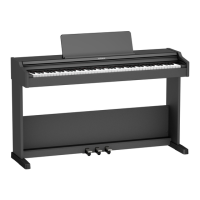
Do you have a question about the Roland RP107 and is the answer not in the manual?
| Sound effects | Ambience, Brilliance |
|---|---|
| Tones quantity | 15 |
| RMS rated power | 8 W |
| Speaker diameter | 120 mm |
| Number of speakers | 2 |
| Maximum polyphony (notes) | 256 |
| Keys quantity | 88 keys |
| Number of keyboard sensitivity levels | 5 |
| Bluetooth version | 4.2 |
| Headphone outputs | 1 |
| USB connector type | USB Type-A, USB Type-B |
| Tuning frequency | 415.3 - 466.2 Hz |
| Demo songs quantity | 377 |
| Power source type | AC |
| Product color | Black |
| Depth | 410 mm |
|---|---|
| Width | 1378 mm |
| Height | 982 mm |
| Weight | 37000 g |
Explore various built-in instrument tones and layering options for versatile performances.
Utilize built-in songs and the metronome for practice and rhythm development.
Record and playback keyboard performances to analyze and improve playing skills.
Stream music wirelessly from a mobile device to the piano's speakers.
Use apps for expanded tones, interactive lessons, and practice assistance via Bluetooth MIDI.
Select single tones or layer two tones for performance.
Select and play built-in songs or songs from a USB drive.
Configure keyboard tone and damper resonance for SMF playback.
Adjust metronome start/stop, volume, time signature, and tempo.
Adjust ambience, headphone ambience, and brilliance for sound customization.
Split the keyboard into zones and adjust key touch sensitivity.
Match tuning to other instruments and transpose the keyboard pitch.
Adjust song/audio volumes and configure the Auto Off function.
Copy recorded songs to a USB flash drive for backup.
Learn how to safely open and close the piano's keyboard cover.
Connect USB computer, DC in, and pedal to the rear ports.
Connect headphones and USB memory to the bottom ports.
Learn how to turn the piano on/off and adjust the volume levels.
Understand the function and operation of the sustain, sostenuto, and soft pedals.
Instructions for attaching and stabilizing the music rest.
Choose from a variety of built-in tones or connect to apps for more options.
Navigate and play songs categorized by genre or learning purpose.
Start/stop, adjust volume, time signature, and tempo of the metronome.
Learn to record, standby, and save keyboard performances.
Copy recorded songs to a USB drive for backup or sharing.
Configure sound output for headphones and built-in speakers simultaneously.
Save settings that are automatically backed up and those requiring manual backup.
Restore all settings and internal data to factory default conditions.
Stream music from your mobile device to the piano's speakers via Bluetooth.
Connect to apps like Roland Piano App using Bluetooth MIDI for enhanced features.
Step-by-step guide for pairing your mobile device with the piano for audio and app use.
Reconnect to previously paired mobile devices for audio and app functions.
Adjust the volume of audio received via Bluetooth from your mobile device.
Configure settings to connect the piano with specific apps via Bluetooth MIDI.
Verify that the piano's Bluetooth function is enabled.
Close all apps on the mobile device to resolve connection issues.
Forget existing pairings, turn off Bluetooth, and restart the device.
Address issues like no sound output, incorrect pitch, or doubled sounds.
Troubleshoot issues with reverberation, note resonance, and ringing sounds.
Resolve problems with buzzy low notes, inconsistent tone, or distorted sound.
Resolve problems with pedal functionality and song playback volume/selection.
Troubleshoot recording volume differences, settings changes, and headphone thumping.
Address issues with automatic power-off, power failure, and blinking indicator errors.
Learn the meaning of warning symbols and notices for safe operation.
Follow guidelines for AC adaptor, power cord, moving, bench use, and child safety.
Notes on AC adaptor placement, keyboard care, and avoiding damage.
Advice on backing up data and general usage precautions.
Guidelines for external memories, RF emissions, and intellectual property rights.
Specifications for sound generator, keyboard type, and Bluetooth compatibility.
Details on power supply, consumption, physical dimensions, and unit weight.
Browse and select songs for listening, primarily classical and piano pieces.
Explore ensemble pieces and educational Do Re Mi songs.
Access scales, Hanon, Beyer, and Burgmüller exercises for technical development.
Explore classical pieces by Czerny and other composers, plus traditional tunes.
